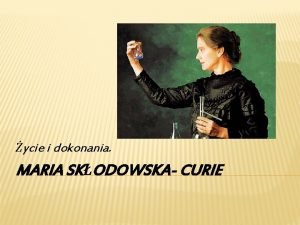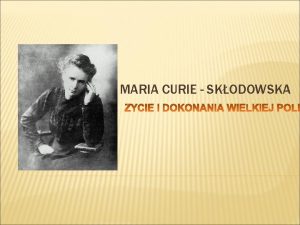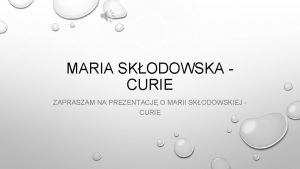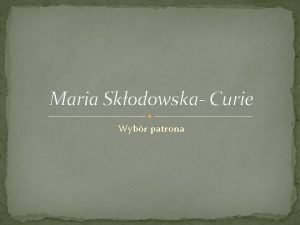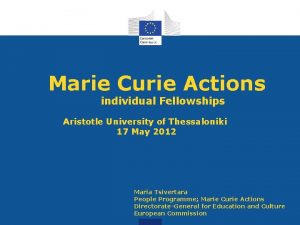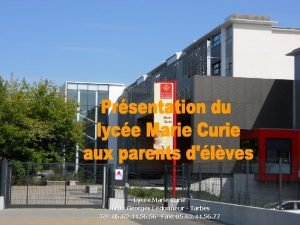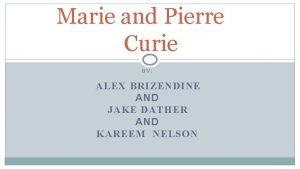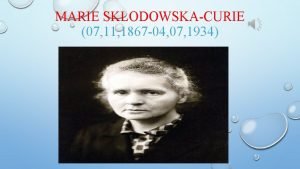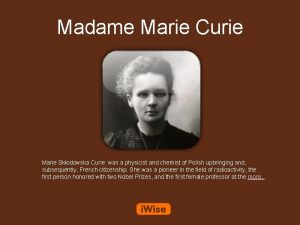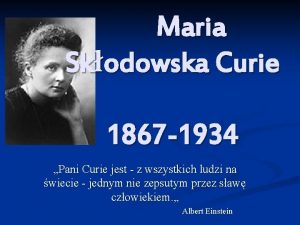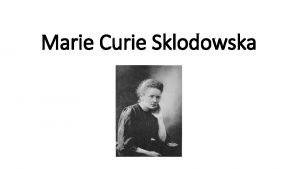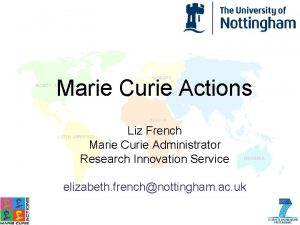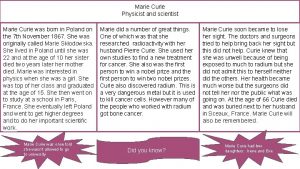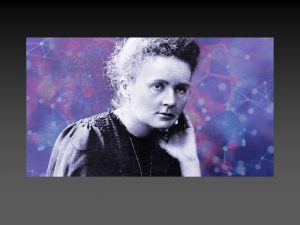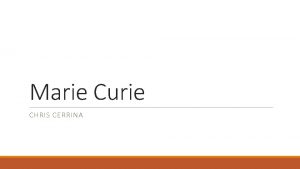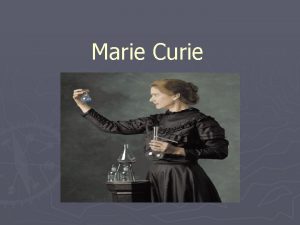Marie Curie Marie Skodowska Curie often referred to













- Slides: 13

Marie Curie

�Marie Skłodowska- Curie, often referred to as Marie Curie or Madame Curie (7 November 1867 – 4 July 1934), was a Polish physicist andc hemist

� Maria Skłodowska was born in Warsaw, in the Russian partition of Poland, on 7 November 1867 � Maria's paternal grandfather Józef Skłodowski had been a respected teacher in Lublin � Her father Władysław Skłodowski taught mathematics and physics, subjects that Maria was to pursue � Maria's mother Bronisława operated a prestigious Warsaw boarding school for girls; she resigned from the position after Maria was born

� When she was ten years old, Maria began attending the boarding school of J. Sikorska; next Maria attended a gymnasium for girls, from which she graduated on 12 June 1883 with a gold medal � Unable to enroll in a higher education institution due to being a female, she and her sister Bronisława became involved with the � She took a position as governess: first as a home tutor in Warsaw; then for two years as a governess in Szczuki , in that time she fell in love with Kazimierz Żorawski, a future eminent mathematician but they didn’t merried. � In early 1889 she returned home to her father in Warsaw. She tutored, studied at the Flying University, and began her practical scientific training (1890– 91) in a chemical laboratory at the Museum of Industry and Agriculture at Krakowskie Przedmieście 66 Birthplace on ulica Freta in Warsaw's "New Town" – now home to the Maria Skłodowska-Curie Museum

In late 1891 she left Poland for France In Paris �Marie had begun her scientific career in Paris with an investigation of the magnetic properties of various steels, commissioned by the Society for the Encouragement of National Industry. That same year Pierre Curie entered her life; it was their mutual interest in natural sciences that drew them together. Pierre was an instructor at the School of Physics and Chemistry �In Pierre, Marie had found a new love, a partner, and a scientific collaborator on whom she could depend.

New elements In 1895, Wilhelm Roentgen discovered the existence of X-rays She used an innovative technique to investigate samples. Fifteen years earlier, her husband his brother had developed a version of the electrometer, a sensitive device for measuring electrical currents. [16] Using Pierre's electrometer, she discovered that uranium rays caused the air around a sample to conduct electricity. [16] Using this technique, her first result was the finding that the activity of the uranium compounds depended only on the quantity of uranium present

� In 1897, her and s daughter Irène was born � To support the family, Marie began teaching at the École Normale Supérieure(In 1900, Marie became the first woman faculty member at the École Normale Supérieure, and Pierre joined the Sorbonne's faculty) � In July 1898, Marie and her husband published a paper together, announcing the existence of an element which they named "polonium", in honour of her native Poland, On 26 December 1898, the Curies announced the existence of a second element, which they named "radium" from the Latin word for ray. [12][18][24] In their research they also coined the word radioactivity

In December 1903, the Royal Swedish Academy of Sciences awarded Pierre Curie, Marie Curie and Henri Becquerel the Nobel Prize in Physics

She was the sole winner of the 1911 Nobel Prize in Chemistry.

War � During World War I, Marie became the Director of the Red Cross Radiology Service and set up France's first military radiology centre, operational by late 1914 � After a quick study of radiology, anatomy and automotive mechanics she procured x-ray equipment, vehicles, auxiliary generators and developed mobile radiography units, which came to be popularly known as petites Curies ("Little Curies")

Famous and remarkable person Marie Curie � Marie Curie was the first woman to win a Nobel prize, the first person to win two Nobel Prizes, the only woman to win in two fields, and the only person to win inmultiple sciences. [69] Awards that she received include: � Nobel Prize in Physics (1903) � Davy Medal (1903, with Pierre) � Matteucci Medal (1904; with Pierre) � Elliott Cresson Medal (1909) � Nobel Prize in Chemistry (1911) � Soviet postage stamp (1987) � Franklin Medal of the American Philosophical Society (1921) Led by Curie, the Institute produced four more Nobel Prize winners, including her daughter Irène Joliot-Curie and her sonin-law, Frédéric Joliot-Curie.

The monuments



